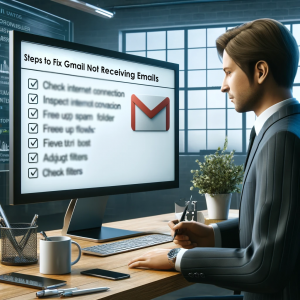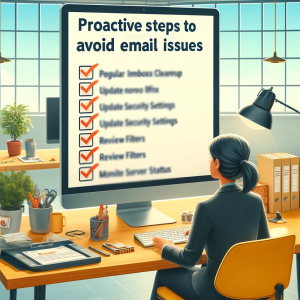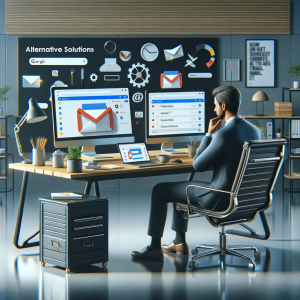Gmail Not Receiving Emails
In today’s digital era, email stands as a cornerstone of communication, serving as an essential conduit for personal exchanges, professional collaboration, and vital information flow. However, encountering issues such as Gmail not receiving emails can disrupt both daily life and business operations, leading to missed opportunities and significant stress.
Many users find themselves perplexed and frustrated when they notice that Gmail is not receiving emails. This issue can stem from various reasons, some easily fixable and others requiring a bit more troubleshooting. If you’re noticing that your Gmail is not receiving emails, you are not alone. It’s a common problem faced by countless users worldwide, prompting concerns over lost productivity and missed communications.
In some cases, the problem could be as simple as Gmail not accepting emails due to an overlooked setting or an overloaded inbox. Understanding the underlying causes and exploring comprehensive solutions are crucial first steps in reclaiming your digital communications stream.
This introduction prepares us for a deeper dive into the common reasons why Gmail not receiving emails occurs and how to effectively address these issues to ensure your inbox stays active and receptive to all your important emails.
Common Causes of Gmail Not Receiving Emails
Email delivery issues can be highly disruptive, particularly when it comes to a reliable service like Gmail. Users often find themselves baffled and inconvenienced when they notice Gmail is not receiving emails. Several factors could be contributing to this problem, and understanding these can help in quickly resolving the issues.
-
Account Issues
One of the most straightforward reasons your Gmail is not receiving emails could be a full inbox. Gmail provides a generous amount of storage, but it’s not infinite, and once you reach the limit, new emails will stop coming through until space is freed up. Similarly, if your account isn’t properly synced on all devices, or if there are access issues perhaps due to security settings or password problems, you might find that mail is not received in Gmail.
-
Spam Filter Settings
Another common culprit is the overzealous spam filter. At times, Gmail’s filters might redirect legitimate emails away from your inbox and into the spam folder, leading to mails not receiving in Gmail as expected. It’s essential to regularly check the spam folder and adjust the filter settings if you notice that important emails are being mislabeled as spam. If you still face issues with spam filter, you can read our blog on Gmail Spam Filter Not Working and get the solution.
-
Network Problems
Connectivity issues can also lead to email delivery problems. If your internet connectivity is not stable, slow, or down, email not received quickly can be a frequent issue. Emails may take longer to load or might not appear until connectivity is restored.
-
Server Outages
Lastly, server outages impacting Gmail can prevent emails from being received. While Google’s servers are highly reliable, they are not immune to problems. During these outages, you might notice that my Gmail is not receiving emails at all. Checking Google’s Dashboard or related status update platforms can confirm if there is a widespread problem affecting Gmail services.
Understanding these common causes helps to set the foundation for troubleshooting Gmail not getting emails and ensures that you can take the appropriate steps to resolve the issue, whether that’s cleaning up your inbox, adjusting your spam settings, ensuring your network is stable, or simply waiting out a Gmail service disruption.
Steps to Fix Gmail Not Receiving Emails
When you find yourself asking, Why am I not receiving emails in Gmail? a systematic approach can help you find and resolve the problem. Here’s a detailed step-by-step guide that covers common troubleshooting steps to ensure your Gmail starts receiving emails again.
-
Check Your Internet Connection
A stable internet connection is important for receiving emails quickly. If you’re experiencing delays or notice no emails are coming through Gmail, the first step is to verify your internet connectivity. Check if other online services are working and restart your router if necessary. A poor connection often leads to issues with Gmail not receiving emails.
-
Inspect Spam and Trash Folders in your Gmail Account
Emails sometimes get misdirected to the Spam or Trash folders. Regularly checking these folders can help you recover important emails that Gmail might have filtered out by mistake. This step addresses the common concern of not receiving emails on Gmail, as misplaced emails can often be found here.
-
Ensure Sufficient Storage Space in Gmail account
If your Gmail is nearing its storage limit, it may stop receiving new emails. To address Gmail not receiving emails due to space issues, try clearing out large or old emails, and empty your Trash folder to free up space. This step is crucial for users who frequently ask, Why am I not getting emails on Gmail?
-
Check Filter and Blocking Settings of your Gmail Account
Incorrectly set filters or blocked addresses can prevent emails from arriving in your inbox. Review your Gmail settings to ensure that important senders are not blocked or filtered incorrectly. Adjusting these settings can often resolve issues related to not receiving emails on Gmail.
-
Verify Email Forwarding Settings of your Gmail Account
Sometimes, email forwarding settings might redirect incoming emails away from your Gmail account. Ensure that you haven’t accidentally set up forwarding that could be diverting emails to another email address, which is a less obvious reason for not receiving emails in Gmail account.
-
Look for Server Outages
Finally, check if there are any known issues with Gmail’s service that could be affecting email delivery. Google’s Workspace Status Dashboard can provide current information on any ongoing server outages that might explain why Gmail is not receiving emails.
By following these steps, you should be able to diagnose and resolve most issues related to Gmail not receiving emails. This guide helps streamline the process, ensuring you don’t miss out on important communications.
Advanced Solutions for Gmail Not Receiving Emails
When basic troubleshooting doesn’t resolve your issue with Gmail not receiving emails, it may be time to employ some advanced techniques. These steps are designed for those who continue to experience persistent issues, such as Gmail not loading new emails or Gmail stopped receiving emails. Here’s how to dive deeper into resolving these frustrating issues.
Using Gmail’s Checkup Tool
Gmail offers a built-in troubleshooting tool known as the Gmail Checkup Tool, which can be instrumental in diagnosing and resolving email reception problems. This tool performs an automated scan of your account settings to identify any potential issues that might stop emails from arriving in your inbox. If you’re puzzled about how to fix Gmail not receiving emails, utilizing this tool should be one of your first steps. It checks for filter settings that could be misdirecting emails, ensures that forwarding settings are correct, and even alerts you if your storage capacity is nearing its limit, which might cause Gmail storage full and not receiving emails.
Using this advanced troubleshooting technique provides a deeper level of investigation into issues like Gmail not receiving emails. Whether it’s a hidden setting issue detected by the Checkup Tool or a more complex problem that requires Google’s direct intervention, these steps are crucial for restoring your Gmail’s functionality and ensuring you don’t miss important communications.
Proactive Steps to Avoid Gmail Not Receiving Emails
To avoid the common issue of Gmail not receiving emails, proactive prevention and a solid understanding of email mechanics are key. By maintaining your Gmail account regularly and educating yourself on email protocols, you can ensure that issues such as Gmail is not receiving emails occur less frequently. Here are detailed prevention tips and insights:
Regular Gmail Account Maintenance
Effective management of your Gmail account is crucial for preventing problems like not receiving Gmail emails. Implement these best practices to keep your account in optimal condition:
-
Gmail Account Inbox Management:
Regularly clean your inbox to avoid reaching capacity, which is a common reason why Gmail is not receiving emails. Periodically deleting old emails and clearing spam can prevent storage issues that block incoming messages.
-
Filters and Rules Check:
It’s important to frequently review any set filters or rules to ensure they are not misdirecting or blocking important emails. This is vital for preventing scenarios where your Gmail account is not receiving emails.
-
Update Security Settings of your Gmail Account:
Keep your recovery options current and enhance security with regular password updates and two-factor authentication. This helps safeguard against unauthorized changes that could result in Gmail not receiving emails. If you face unauthorized access in your Gmail account, you can read our blog on Gmail Account Hacked and learn how to get access back.
-
Regular Security Audits of your Gmail Account:
Ensure that your security settings are intact to prevent breaches that could alter your email settings, leading to not receiving Gmail emails.
Understanding Gmail Email Protocols and Configurations
A thorough grasp of email protocols and configurations enhances your ability to troubleshoot and prevent Gmail not receiving emails:
-
SMTP (Simple Mail Transfer Protocol):
This protocol handles your outgoing emails. Incorrect SMTP settings can interfere with receiving messages, leading to complaints of Gmail not receiving emails.
-
IMAP and POP:
Understanding these incoming email protocols is crucial. IMAP synchronizes your emails across all devices, which helps in managing your emails more effectively. POP, while useful, can cause issues like not receiving Gmail emails if configured to delete emails after downloading to one device.
By deepening your knowledge of these protocols and actively maintaining your Gmail account, you can minimize the risk of encountering Gmail not receiving emails. Regular updates, security checks, and an informed approach to email settings are your best defenses against disruptions in email delivery.
Alternative Solutions for Gmail Not Receiving Emails
For those facing persistent issues such as Gmail not receiving emails or Gmail not sending emails, considering alternative email clients and comparing the functionality between the Gmail mobile app and web browser might provide effective solutions. This section explores the advantages and drawbacks of these alternatives, which can help alleviate problems like emails not showing up in Gmail.
Using Different Email Clients
Switching from the Gmail interface to another email client is a viable option for users experiencing Gmail not sending or receiving emails. Here’s an in-depth look at the pros and cons of this approach:
-
Pros:
-
Enhanced Features:
Alternative clients may offer unique features that aren’t available in Gmail, potentially improving your email management.
-
Customization Options:
These clients often allow more customization, which can better suit personal preferences or workflow requirements.
-
Software Integrations:
Some clients integrate better with certain third-party applications that Gmail does not, enhancing functionality.
-
-
Cons:
-
Increased Complexity:
With more features comes increased complexity, which might be a challenge for those accustomed to Gmail’s user-friendly interface.
-
Syncing Challenges:
There could be issues with how emails are synced or archived, potentially leading to problems like not getting emails on Gmail when using the alternative client.
-
Mobile Gmail App vs. Web Browser
The choice between accessing Gmail through its mobile app or a web browser can also impact issues related to Gmail not receiving emails or Gmail not sending emails:
-
Mobile App:
-
Pros:
Offers greater accessibility and the convenience of instant notifications, which is ideal for users needing to manage emails on the move.
-
Cons:
The smaller screen and somewhat limited features compared to the web version might restrict complex email tasks.
-
-
Web Browser:
-
Pros:
Provides access to the full suite of Gmail features, including all integrations and extensions that enhance email management capabilities.
-
Cons:
It’s less practical for users frequently away from their desks, and browser-specific issues can affect email display and management.
-
Selecting the appropriate tool to access Gmail—whether an alternative email client or deciding between the mobile app and web browser—can significantly influence your ability to resolve Gmail not receiving emails. This choice plays a crucial role in how effectively you can manage and rectify issues like Gmail not sending emails or not getting emails on Gmail.
FAQs
Q1. Why is my Gmail Not Receiving Emails?
- A. If your Gmail is not receiving emails, check if your inbox is full, inspect your spam and trash folders for misdirected emails, and ensure your account settings haven’t been mistakenly altered to block incoming messages.
Q2. What should I do if I notice mail not received in my account?
- A. Begin by checking your internet connection and Gmail’s server status. If everything seems normal, review your spam filters and settings to make sure emails are not being redirected or blocked.
Q3. Why am I not Receiving Emails in Gmail even though they’re sent?
- A. Issues like Gmail not accepting emails can occur due to server outages, incorrect filter settings, or even a full Gmail storage. Ensure you have enough storage and that your filters aren’t misconfigured.
Q4. How to fix the issue of Not Receiving Mail on Gmail?
- A. Use Gmail’s built-in Checkup Tool to diagnose and resolve issues. This tool can identify settings that may prevent emails from arriving and provide specific fixes.
Q5. What steps can I take if I’m not getting emails on Gmail that I know have been sent?
- A. Verify that your email forwarding settings are correct, and that no filters are mistakenly rerouting incoming mail. Also, check for any Gmail outages that could be affecting your email reception.
Q6. How can I prevent my Gmail Account Not Receiving Emails in the future?
- A. Regularly update your Gmail settings, manage your inbox space efficiently, and ensure all your recovery options are up to date to avoid issues like Gmail storage full not receiving emails.
Q7. Can server issues cause my Gmail Not Receiving Emails?
- A. Yes, server issues can prevent emails from being delivered to your inbox. Check Google’s Workspace Status Dashboard to see if there are any notifications about Gmail service disruptions.
Q8. What are some signs that Gmail Is Not Loading new emails due to connectivity issues?
- A. Signs include emails taking a long time to load, not appearing in your inbox despite senders confirming dispatch, and general slow performance of Gmail services on your device.
Q9. Why am I Not Receiving Gmail Emails even after checking spam and trash folders?
- A. If you’ve checked these folders and still face issues like Gmail not receiving emails, ensure your Gmail app or client is updated. Sometimes, outdated applications can lead to email syncing issues.
Q10. How to address Not Receiving Email in Gmail account due to incorrect settings?
- A. Regularly review and adjust your Gmail settings, particularly those related to filters, blocked addresses, and forwarding. This ensures that emails are not wrongly filtered out or redirected.
Conclusion
In our exploration of the common problem of Gmail not receiving emails, we’ve covered a comprehensive range of strategies aimed at diagnosing and resolving issues that prevent your Gmail account from functioning optimally. From understanding the simple fixes like checking your internet connection and inspecting spam filters, to delving into more advanced solutions like using Gmail’s Checkup Tool and switching email clients, these steps are designed to ensure that you no longer face the frustration of not receiving mails from Gmail.
It’s crucial to remember that email is a critical communication tool in both personal and professional settings, and issues like not receiving emails from Gmail can have significant implications. By following the steps outlined in this blog, you can address and often rectify these problems, restoring the reliability of your email communications.
We encourage you to regularly apply the maintenance tips and preventative measures discussed. Regular checks and updates can prevent many issues related to Gmail not receiving emails. If you continue to experience problems, consider revisiting the troubleshooting steps and make sure that you have thoroughly examined all potential causes.
Ultimately, by staying proactive and informed about your Gmail settings and the common pitfalls of email management, you can minimize the chances of not receiving mail on Gmail. We hope this blog has empowered you with the knowledge to maintain a seamless flow of communication through your Gmail account.
To know more about Gmail Not Receiving Emails and other related issues and their solutions, visit our Gmail Support page.

Joshua wilson
I’ve checked everything but still, why am I not receiving emails in Gmail? What could be causing this persistent issue?
Support Admin
If you’re wondering, “Why am I not receiving emails in Gmail,” despite checking the usual suspects like internet connectivity and spam folders, you might need to delve deeper into less obvious areas. First, confirm there’s no Gmail storage full not receiving emails issue by cleaning out unnecessary emails and attachments to free up space. If this doesn’t resolve the problem, review any filter and blocking settings that may have been mistakenly applied. Sometimes, emails are rerouted by complex filter rules or the senders might have been inadvertently blocked. Lastly, check if there’s an accidental setting in email forwarding that is directing your emails to another account.
Charles anderson
What should I do if I discover that Gmail is not loading new emails even after basic troubleshooting?
Support Admin
When Gmail is not loading new emails, and basic troubleshooting like checking server status or restarting your devices hasn’t helped, it’s important to consider advanced strategies. Utilize Gmail’s Checkup Tool to scan for any anomalies in your settings that could be blocking incoming mails. If the tool doesn’t pinpoint the problem, consider whether the issue might be related to client-specific problems; for example, ensure your mobile app or web browser is up to date. Sometimes, outdated applications can prevent Gmail from properly syncing and displaying new emails.